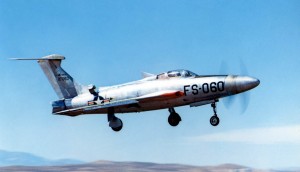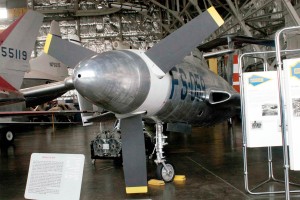
Published July 22, 2012
Without question, 1955 was the loudest year in aviation history. On this date, July 22, 1955, the Republic XF-84H Thunderscreech would make its first flight, setting an aviation-related noise record that will probably never be broken. Only by the Russian Tupolev Tu-95 Bear, with its four engines at full power, nearly achieves the incredible volume of the single engine Thunderscreech when it sat on the ground, its throttle set to idle.
What made the Thunderscreech so loud was the propeller. Connected to the rotating turbine core of the jet engine, a 5,850 hp Allison XT40-A-1 turboprop, it was engineered to rotate at rpms that resulted tip speeds that were supersonic. Forget jet engine noise, which people often complain about when they move in under the departure path of a major airport (hey, it isn’t as if the airport opened AFTER you moved in!), sonic booms are the undisputed decibel level kings of the soundscape. So imagine an aircraft that produced not just one sonic boom when flying overhead, but instead continuously generated a hammering repetitive rhythm of sonic booms with every rotation of its propeller.
What were the designers thinking when they came up with an airplane that had a supersonic propeller? Well, first of all, if you rotate a propeller at supersonic speeds, it is producing a whole lot of power — and as a result, the Thunderscreech was easily slated to set the record for the fastest ever propeller driven airplane. Second, with early jet engines, a propeller (or fan) tied to the rotating jet core was a far more effective way to create aerodynamic thrust than a simple jet, creating improved fuel efficiency (today, high bypass fans are popular with airliners, given the improvements to fuel economy they bring). The Thunderscreech was projected to have a range of over 2,000 miles, not bad for a fighter jet of that era. The noise factor, however, was not something that Republic’s designers quite understood — in fact, until they tried it out, nobody knew how harsh the resulting sonic bomb series could actually be.
Terribly bad, however, doesn’t even begin to describe the result. While a typical single sonic boom can rattle dishes and windows, as happens when a supersonic plane passes overhead at altitude, the Thunderscreech instead produced a high intensity, rolling series of sonic booms — being near it was physically debilitating. Think of it like having a hundred snare drummers doing a drum roll on your chest, head and limbs all at once.

Just running up the Thunderscreech’s engine on the ramp had the power to knock people over, make them sick, disorient them and even cause permanent physical damage — and not just to the ears! The continuous sonic booms it produced could be heard 25 miles away. Ground crew, even with ear protection, reported nausea and headaches just from the start-up sequence. The airfield out at Edwards AFB, already well acquainted with test aircraft noise, had to request that the Thunderscreech be towed off the airfield and out onto a distant part of the dry lake bed before starting.
Mercifully, the USAF cancelled the program in September 1956 after just two were built. The reason wasn’t the noise, however, but vibration problems and the longitudinal stability issues created by the huge amount of torque the prop produced. Put simply, at speed, the plane would uncontrollably nose off its heading into a straight line slip called “snaking” in test pilot slang. With the retirement of the test planes, a new quiet returned to Edwards AFB, except, of course, for the usual sounds made by all of the X-planes, rockets, high performance jets and other developmental aircraft that typified the atmosphere of Edwards in those days.
Ahh, the good old days — but remember your wear ear protection!
One More Bit of Aviation History
The XF-84H Thunderscreech likely set a radar reflection record as well, though to our knowledge, nobody was checking. Radar, as every stealth engineer can attest, reflects off of all surfaces to some degree (some surfaces more than others) and reflects best off of panels that angled 90 degrees to each other (thus giving rise to flying wings, faceted surfaces, in-canted paired vertical stabilizers and the other various shapes one sees in the stealth world). However, radar also reflects off of sonic boom shock waves. That is why until recently stealth aircraft were subsonic — the reflection off of a sonic shock wave looms large on a radar scope for all to see. As many air-to-air missiles are radar guided, by the 1960s, this was already a very important issue. The XF-84H Thunderstreak most likely would have shown on a radar scope as something bigger than a battleship flying along at subsonic speeds, making it an easy target. In retrospect, the Thunderscreech seems to have been a bad project no matter which way you look at it.

I remember seeing this airplane on a pole in front of bakerfeild airport years ago. It just looked weird!!
Love this aircraft. Thanks.